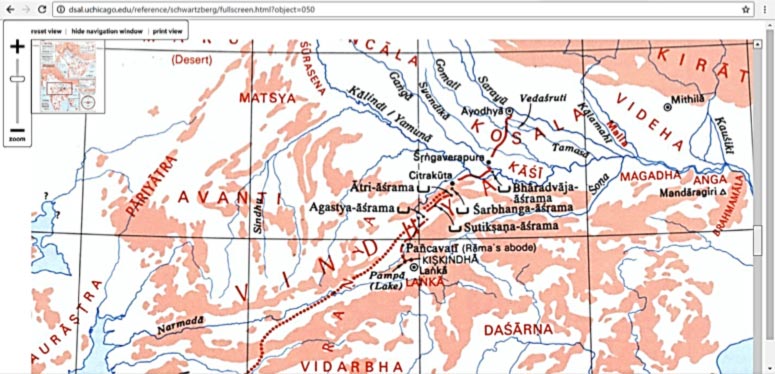
Shereen Ratnagar
This question is not framed appropriately. Which story of the Ramayana? In any case, the epic is dated relatively late, and Ayodhya falls outside the Harappan occupied zone.
Massimo Vidale
As far as I know, no; but I am not a philologist.
Mayank Vahia
Ramayana is the story of Lord Rama and the social crisis of his life regarding the word given by this father and the sacrifice a son makes for the same. It also involves issues regarding the responsibility of a wife to a husband, that of a brother to another brother and a whole host of other moral issues in a somewhat idealised environment. It is heavily layered with various issues of life and society, personalities, cultural values and clash of values etc. It remains one of the most popular epics especially in the Hindi speaking belt of India. The story is heavily worked and has several references that seem to have been later additions.
There are no reliable references to astronomical constellations, conjunctions etc. in the original text. Hence dating Ramayana is more easily said than done. There have been claims of references to astronomy in terms of finding references to chart the location of stars in different constellations at the birth of Rama. Creating such charts is a common a practice in India today. On the basis of this, it is not unusual to suggest the period of Rama to be round 5000 BC but the orthodoxy would claim Ramayana to be dated before 24,000 YBP. However, there are several reasons why this is difficult to accept. It claims references to constellations that were not designed until about 3000 BC, our knowledge of the ephemeris of planets is not accurate enough to allow us to extrapolate that far into the past etc. Also, critical editions of Ramayana created by methodically analysing the linguistic structure and removing later additions, suggest that these are later additions.
The description of lifestyle however, is very revealing. Rama’s birth is supposed to have taken place in a city called Ayodhya, a city on the Gangatic plane. It is based in a culture where the life is relatively simple in terms of sophistication of governance and is light on describing the rules of governance etc. This is in complete contrast to Mahabharata which defines the rules of governance, responsibilities and duties of the king etc. in great detail.
In the story, Rama’s father Dashrath grants a boon to his second wife (polygamy explicit – Dashrath had 3 wives) Kaikeyi. Kaikeyi demands that the rains of the kingdom should be given to her son Bharat instead of Rama, the son of the elder wife Kaushalya. She also demands that Rama should leave the kingdom for 12 years. When Rama leaves his kingdom, his wife (Seeta) and brother (Laxman) follow him to the forest. This description of Rama leaving is one of walking away. There are no horses for them to travel and bullock carts are also not mentioned. The entire description is of a social environment that is technologically challenged. Horse enters the Ramayana towards the very end, when his sons challenge him.
By contrast, the IVC is spread in Western part of the Indian subcontinent and spread to the East only towards the end of its urbanization, closer to 1900 BC or so. By that time, they were not only well past basic urbanization but clearly had a fairly sophisticated economy, long distance trade, high levels of standardization etc. So when they eventually reach the region close to the present day Ayodhya, they initiate a highly complex urbanisation that is often referred to as the second urbanisation of India. The earliest evidence of settlements there would be more like 1000 BC though. They then go on to form what are called Janapadas (people’s republics by name but proper kingdoms ruled by kings) etc. and in fact first punch marked coins are found here, dated to about 500 BC or a little earlier. Krishan is also supposed to have been born. This is where Buddhism would arise and the Golden Period of Indian Civilisation (700 BC to about 200 AD) is in this region. It is from here that Ashoka would go on to create a nation that spread from Afghanistan the Bramhaputra Valley.
Given this contrast, it is probably safe to assume that Ramayana predated this arrival of IVC people in the Gangetic planes. There are other evidences to this. For example, the island of Lanka of Ramayana is almost certainly a small island in one Lake Pampa on Narmada. To me, what clinches the issues is that there is no description of vegetation exclusively south of Vindhya in Ramayana. Even a quick look at the Wikipedia list of flora and fauna of Ramayana will show you that the plants described are either generic to all India or restricted only to north India, north of the Vindhyachal Mountains that run East West along central India.
Lanka in Sanskrit means island. Sri Lanka therefore is simply means a large island. Ramayana refers to Lanka, Sri Lanka comes up more around 500 AD when Aryabhata refers to it as a location at Equator. So the confusion between Lanka and Sri Lanka is a later confusion.
I am enclosing with this a map from University of Chicago’s online map of ancient India [Image 2].
However, Ramayana is linguistically modern compared to Mahabharata. It therefore seems to me that the Sanskrit speakers, on reaching the Gangetic planes, heard this touching story and wrote it down in Sanskrit.
Above: King Dasaratha and His Retinue Proceed to Rama's Wedding: Folio from the Shangri II Ramayana Series
Bahu Masters (active ca. 1680–ca. 1720). Image courtesy Metropolitan Museum of Art. Map courtesy Mayank Vahia.
